
There is nothing wrong with looking at friendly society history in institutional terms. To do so, however, may result in the fundamental truth, that they were created by and for people with specific needs in mind, being overlooked. Without the efforts of individuals there would have been no courts, no lodges, no friendly societies. It seems only proper, therefore, to both commemorate and celebrate the lives of the tens of thousands of active members who served in one capacity or another.
Foe every one member who was active there were ten, a hundred, a thousand, who belonged principally for the reassurance of knowing that when ill, the society or ‘club’ would be there with contracted for financial benefits. Beyond this was neighbourly, informal, concern and assistance between families. This was the culture of care for which friendly societies were justifiably famous.
What’s special about OUR collection of AOF people related material?
| > | An un-rivalled run of the Order periodical, the Foresters’ Miscellany, provides unparalleled biographical details of active members from throughout the UK; |
| > | Account and Minute books reveal the worth, in financial and practical terms, of membership of the AOF. |
Subject Headings Banners |
Further Reading None Known |
 |
 |
 |
 |
 |
 |
 |
 |
 |
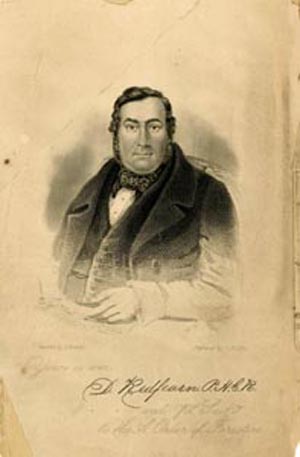 |
David Redfearn Founded in 1834, the Ancient Order of Foresters did not have any paid officials supporting the national Executive Council (EC) until August 1841. At the High Court Meeting (HCM) at Warrington, Lancshire, that year, David Redfearn was appointed to the newly created post of Permanent Secretary to the Order. His credentials were sound, having been High Chief Ranger (HCR) in 1839/40, when the EC was based in Dewsbury, West Riding of Yorkshire. A native of Mirfield, near Dewsbury, at the age of 45 he was appointed to relieve EC members of the many routine and onerous tasks associated with their role, such as despatch of goods to Courts and Districts. 15 months later, out of the blue, he absconded, taking a ship from Liverpool to the USA under an assumed name, with a member’s wife and some of the High Court funds. Initially understanding and forgiving, as the truth emerged, the St Helens EC recorded in February 1843 ‘Matters have transpired also, since he left St Helens, that lead us to imagine, not so spotless as we previously imagined him to be, but have not the means at present to ascertain correctly, and are also afraid to make the effort to examine.’ This portrait of David Redfearn, the first of its type, was published with the EC Address of May 1841. The original painting was by G Bartlett and the engraved plate for printing prepared by T H Ellis. |
|
| Back to Top | ||
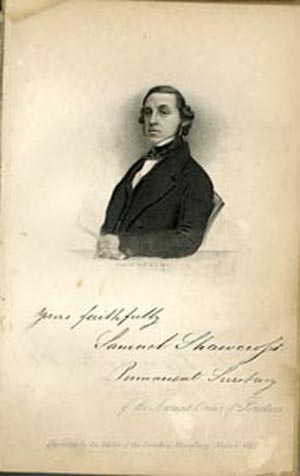 |
Samuel Shawcross As their second Permanent Secretary, members chose a 21 year old from Stockport, Cheshire, Samuel Shawcross. Son of a small cotton master, he attended the 1843 HCM at St Helens, Lancashire, as the delegate of Court “Albion Rose”, No. 521 and left with a new job and an uncertain life ahead. At that time he could not have envisaged that for the next forty six years of his life he would, every year in August, be required to up sticks and move home to a different part of the UK. The cause of this was the peripatetic nature of the AOF governing arrangements, which required the EC to come from a different area each year, requiring all the supporting administrative arrangements to be relocated accordingly. This was not just a whim but intended to prevent any group or individual obtaining a position of undue influence within the Order, seen by many as the reason for the great secession of August 1834. In his 46 years of service Samuel Shawcross saw many great changes in the AOF, reflecting on his voluntary retirement in August 1889, from a personal point of view, the satisfaction of ‘placing our Courts in their proper position as legal branches under the Friendly Society Act of 1875, and the pleasure it has given me in having put the rules of some thousands of Courts into an intelligible form for registration under the Act.’ Less than four years after his retirement, on 21st April 1893, Samuel Shawcross died at home in London. |
|
| Back to Top | ||
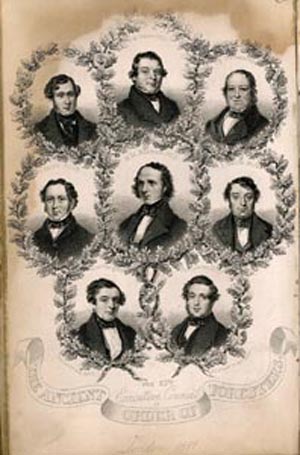 |
London EC 1843/4 In selecting London as the venue for the 1844 High Court Meeting delegates to the Hull 1842 HCM took a significant step in creating for the Order a future not restricted to the north of England. Courts were by this time beginning to be formed in southern, eastern and western counties of England, and in Scotland and Wales, but the explicit choice of ‘Londoners’ to form the Executive Council encouraged the aspirations of many across the UK. The London EC consisted of some of the most active and ardent early advocates of the Order. The High Chief Ranger, Bro Henry M Bayfield, was, on the amalgamation of two London Districts to form the London United District, elected District Secretary. Credited with ‘untiring exertions in the benevolent work’ of establishing a Widows and Orphans Fund in the District, these were it seems ‘too much indeed for a constitution not the most robust’, and within a year, aged just 34, he died of consumption and was buried in Highgate Cemetery, north London. Other active workers were Robert Wright and William Wale, both of who within 5 years were rebelling against the established ways of the Order. William Loader was a tireless spreader of the Forestric word and participated in the opening of at least 10 Courts in 1841/42. |
|
| Back to Top | ||
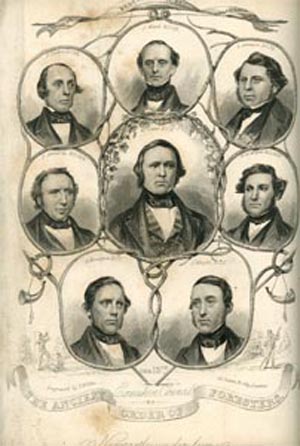 |
Newcastle-under-Lyme EC 1846/7 Staffordshire first became colonised by Foresters in 1837, with the founding of Court “St Clements”, No. 497 at Newcastle-under-Lyme. On 20th January 1844, William Coates, a significant and influential man for most of his short life, joined Court “Royal Miners”, No. 548, beginning a meteoric ascent within the Order. Just over two and a half years later, he became High Chief Ranger when Newcastle-under-Lyme was given the privilege of hosting the High Court Meeting and Executive Council. Depicted here as a powerful looking figure, it is sad to record that only 11 work filled years later, at the age of 36, he died from diseased lungs, an illness that had ‘worn him to a perfect skeleton.’ In Forestry, as in his involvement with the potters trade society and as a preacher with the New Connexion Methodists, this was ‘ a man whose life had had a purpose – a good purpose, a benevolent purpose, and who had the rare power to accomplish his purpose, leaving the world better than he had found it.’ Another outstanding member of the 13th EC was Ralph Parker, who became a Trustee of the Order, serving in this capacity until his death in 1895.
|
|
| Back to Top | ||
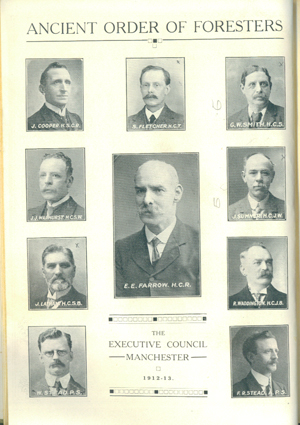 |
Manchester EC 1912/3 The installation of the members of the incoming Manchester EC at the Leicester HCM in August 1912 marked the end of an era for the Foresters. Since 1834, a tried and trusted system of electing 8 men from a particular locality in the UK had enabled men from Aberdeen to Plymouth, from Cardiff to Norwich, to use their ability and commitment to the Forestric ideal in the service of their fellow members. Over time the extent of an area to which Courts could nominate potential EC members had increased from 6 to 20 miles from a given point in a city or town. Effectively, however, despite the many democratic features of the AOF, this was a restrictive practice, recognised as such as the new era of state organised National Insurance Act began. It was fitting that Manchester was the last location to be selected under what was called the ‘Migratory’ system of government, as it had been the first in 1834/35, and twice subsequently. The 79th EC of the AOF consisted of men of great experience and authority. Four were District Secretaries, namely Bro Enoch Farrow, High Chief Ranger, Manchester; Bro T Cooper, High Sub Chief Ranger, Stockport; Bro Samuel Fletcher, High Court Treasurer, Glossop Dale and Bro Joseph Sumner, Hogh Court Junior Woodward, Wilmslow; The High Court Junior Beadle, Bro Robert Waddington was District Treasurer, Bolton. |
|
| Back to Top | ||
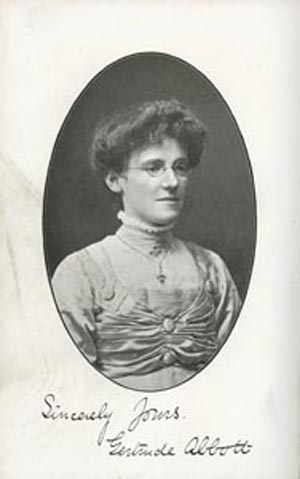 |
|
Gertude Abbott Two distinct honours, separated by 27 years, ensure that Gertrude Abbott has a special place in Forestric history. In October 1910, at the age of 32, she became the first Sister of the Order to be featured in the Foresters’ Miscellany, Scroll of Honour feature. By then she had already served as Chief Ranger of Court “Martha Blakeney”, No. 8108 in Sheffield, West Riding of Yorkshire, the first female Court to be established in the Order, had been the first Secretary of Women Foresters Federation, and most recently, appointed Assistant Secretary of the Sheffield and Hallamshire District of the AOF. The sentiment expressed at the time that ‘the work of Forestry is to her part of her life’, proved very true. In 1919 she succeeded her father, George Abbott as District Secretary, holding that post until the second world war. Her pinnacle of achievement in Forestric terms was attained with her appointment to the Executive Council of the AOF in 1937, the first female to gain such a position. She served on the EC throughout the 1939-45 War years, standing down in 1946. Subsequently a Trustee for many years of the Yorkshire Orphanage and Convalescent Home, she was in later years of her life cared for by the Matron, Miss J M Bellamy. After a long life devoted to Forestry, Gertrude Abbott died in 1969. |
| Back to Top | ||
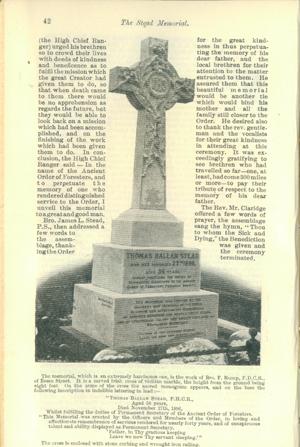 |
Memorials There are, within the cemeteries and burial grounds of the UK, many lasting memorials to the efforts of individual Foresters, in their day respected for their contribution to a caring culture. Shown here is the memorial erected at Norwich Cemetery to Bro. T Ballan Stead, Past High Chief Ranger, Editor of the Foresters Miscellany and from 1889 to 1896, Permanent Secretary to the Order. The memorial was paid for by voluntary subscription, his peers wanting to ensure that the memory of a man who had the task of moving the Order on at a time of major social and political change was perpetuated. A fellow Yorkshireman, John Hepworth, was Leeds District Secretary even before the Ancient Order emerged from the Royal Order in 1834. An influential and much respected personality his is one of the earliest memorials known to have been raised. This was in 1839, his death occurring as he was walking one Saturday evening to attend a Court Meeting. John Hepworth was a man of whom it was said that he ‘never considered any effort too much, nor any sacrifice too great, to be made for the good of the Order, for his generous mind embraced the whole fraternity, and it was his chief study – his principal delight - to be instrumental in any way in promoting the interest and welfare of all or any of his brethren.’ |
|
| Back to Top | ||
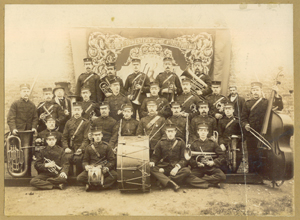 |
Tottenham Foresters Band In this view of 1895, younger members of Court “Foresters Home”, No. 3252 pose in front of the Court banner. Quite astonishingly the names of the band members are listed on the back of the photograph. Thus Bass Drum was W Marsh, side drum, E Wickens, Euphonium, S Wilkinson, String Bass, W Dryden, etc., with the Band Master, Bro G Horne. At the Holcombe Hall, High Road, Tottenham on 18th March 1895 a Variety Entertainment in aid of the funds of the Tottenham Foresters Band was arranged. On the Bill, it was announced that ‘the following talented Artistes will appear.’ Mr W. H. Estall, ‘Eccentric Comedian’ and Mr J. D. Hopkins, ‘Descriptive Vocalist’ headed the list. Others included Prof Van Gelder, ‘the Youngest Eccentric Illusionist in the World’, Mr Chas Ashdown, ‘Loose Leg Comedian’ and Miss Dolly St George, ‘Serio and Dancer’. Mr Tom Caufield, ‘Banjoist, vocalist and dancer’, was in addition, the Stage Manager. With prices of Admission at 1s (5p) or 6d (2.5p), there was every expectation of an enjoyable evening in aid of a worthy cause. |
|
| Back to Top | ||
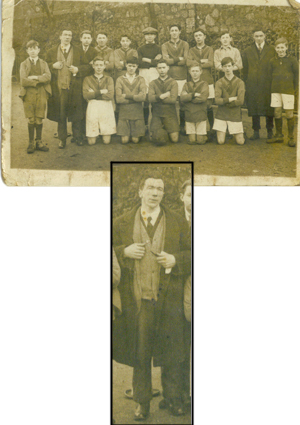 |
Plymouth Foresters Footballers This picture of the Court “Hearts of Oak”, No. 3021 football team based in Plymouth, shows those youngsters, all juvenile members, in the 1922/23 season. With over 374 voluntary members and 533 state insured members in 1923, it was no doubt, a bit of a relief from financial paperwork for the Court Treasurer, Bro L H Varcoe, to be engaged in the pure sport of football! He can be seen to the left standing in a rather schoolmasterly pose. The family nature of Forestry has always been a feature of membership, so it is no surprise to find the team possessing another Varcoe, young Stan, standing on the extreme right, and a relative by marriage, Tom Ross, fourth from left. The Devon and Cornwall Juvenile Football League was, during the late 1920's, in a thriving state. In the 1927/28 season, for example it comprised 8 teams from Courts in the District. As ever, there was a 'feeling in some quarters that money and energy expanded in this direction is wasted', however the contrary view was that 'this unique and comparatively new avenue of propoganda' was an effective recruiting tool for future adult members of the Order. Results of the matches were published in local papers, gaining valuable publicity. No doubt for the young players, this 'value for money' element was far from their thought as they stepped out onto the football pitches of Devon and Cornwall to have a robust, competitive match.
|
|
| Back to Top |